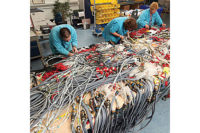Commercial airplanes require an enormous amount of fasteners, but not as much as they once did. For example, the Boeing 747, introduced in 1969, has nearly 1.5 million fasteners. Contrast that with the Boeing 787, introduced in 2009, which has only a few hundred thousand fasteners.
What accounts for this significant reduction? The 787 is made of 50 percent composite materials, which can be assembled with fewer fasteners compared with metal-skinned aircraft.
Increasingly, aerospace manufacturers are designing aircraft and spacecraft made from composites. They also are increasing their use of automation—including gantry cranes and robots—to install fasteners. Suppliers have responded by developing specialty fasteners for composites and creating stronger rivets made of various alloys.
Change in Riveting
Traditional riveting remains a tried-and-true process in aerospace assembly. Aircraft assemblers install millions of solid-shank and blind rivets annually. What has changed are the rivets themselves and that they are more frequently installed with automation rather than manually.
“By adjusting the metal’s chemistry, we’ve been able to increase the strength of our solid rivets more than 10 percent the last few years,” says Omar Honegger, vice president of engineering for Allfast Fastening Systems Inc. “Through grain refinement of the alloys, our rivet bottom can now expand to 1.7 times the original shank diameter with no cracks in the surface, rather than the traditional 1.5 times.”
Solid-shank rivets have a cylindrical shaft with a smooth bottom (buck-tail) and usually a head, although some rivets are headless. Measuring 1/16 to 1/2 inch wide and 1/8 to 3.5 inches long, these rivets are inexpensive (3 to 20 cents each).
Because they offer excellent locking characteristics, solid-shank rivets are used to assemble the primary structures of an aircraft. Mostly they are used to attach skins to the aircraft frame.
Installation requires access to both sides of the rivet. During installation, the head side is air-driven through the hole with an air gun and the bottom is pressed against a bucking bar. The rivet bottom expands to hold the rivet in place.
Two-person installation requires one person to operate the gun and one to hold the bucking bar. One-person installation requires the bucking bar to be firmly fixtured.
Blind rivets are used where there is access to only one side of the structure. Although much more expensive (25 to 70 cents each) than solid rivets, blind rivets provide much less strength. For this reason, they are mostly used to assemble secondary aircraft structures such as ceilings, sidewalls and cabin components.
They consist of a rivet sleeve, a lock collar, a driving anvil, and a serrated stem. During installation, the assembler presses a special tool against the rivet head and pulls the tool trigger. This action clamps the material sheets together, seats the rivet head and breaks off the stem.
Blind rivets are 1/8 to 1/4 inch wide and 1/16 to 7/8 inch long.
In decades past, solid-shank rivets were only made of one or two grades of aluminum alloy. Today they are made of aluminum alloy in one of nine standard grades (1100, 2017, 2024, 2117, 2219, 5056, 7050, 55000 and V-65), as well as titanium, stainless and carbon steel, and nickel and nickel-chromium alloys. Non-aluminum rivets are recommended for locations where corrosion is a concern.
Blind rivets have always been multipiece fasteners, but in the past, the pieces were always made of the same material. That is no longer the case. Suppliers can make rivets of one or more metals (aluminum alloy, stainless steel, and nickel and nickel-chromium alloys) to meet manufacturer specifications.
Head styles on the rivets have not changed, but they are made with tighter tolerances to ensure uniformity and eliminate the need for secondary shaving operations, says Honegger. The AF1061 solid rivet from Allfast features a controlled head that eliminates shaving. Allfast also uses statistical process control to produce rivet heads that have a protrusion tolerance of ± 0.0004 inch.
Solid-shank rivets are available with universal (protruding), modified universal, 100-degree countersunk and expanding heads. Another head type, the NAS 1097 reduced flush, ensures a flush installation in very thin materials.
Some aluminum-alloy rivets have code markings on their heads for easy identification of the alloy. For example, rivets made from 2017-T have a raised teat, while those made from 2024-T have two dashes and those made from 2117-T have a dimple.
The head styles for blind fasteners include universal, 120-degree flush and Unisink, which is a combination countersunk and protruding head for use in very thin top sheets.
Automation on the Rise
Over the past decade or so, aerospace manufacturers have increasingly automated their riveting processes to boost productivity. Automation equipment includes gantry and transporter cranes, as well as robots.
“It has taken more than two decades for automation to take hold in the aerospace industry,” says Dave Littlejohn, manager of marketing and technical sales for Monogram Aerospace. “Monogram’s first involvement happened in the late 1980s when Northrop Corp. studied the effectiveness of automation by using robots to fabricate and assemble the wingtips of their T38 supersonic jet. Our titanium Visu-Lok fasteners were used in that program.”
The study lasted about one year. Fasteners were automatically fed from an on-board cartridge integral to the end-effector, which installed each fastener in a few seconds. Each cartridge held 40 fasteners and weighed 38 pounds when fully loaded.
Littlejohn says Monogram works closely with aerospace manufacturers, robot suppliers and integrators to make sure their fasteners work well in every automation process. Monogram recently worked with Airbus and integrators at the aerospace giant’s plant in Spain to develop a special end-effector that maximizes automation efficiency.
Caleb Lemler, technical services engineer for Cherry Aerospace, says Airbus has been using robots to install rivets and fasteners for several years. More than 3,000 MBC blind rivets are installed in each A330 airliner wing.
The Ergo-Tech blind-fastener installation system by Alcoa Fastening Systems can be handled by a single assembler or it can be mounted to a robot. Luke Haylock, director of new product development for Alcoa Fastening Systems, says the system can be used with a wireless smart tool that uses in-process sensors to provide real-time feedback. The lightweight tool measures the angular rotation and installation torque of each fastener, and compares the results to a predetermined acceptance criterion.
Cherry and Allfast also make tooling to speed up manual installation of blind rivets. The G746A Cherry power riveter is a hydropneumatic tool that can be equipped with straight, offset and right-angle pulling heads. Cycle time is one second.
Allfast makes the RV3000 MaxMatic self-feeding riveter, which holds 40 to 100 rivets on a strip in its magazine. The operator presses the handle to activate. After a rivet is installed, the nose retracts and the next rivet is inserted in the nose. The RV3000 is used by assemblers at Bombardier and Boeing.
Specialty Fasteners for Composites
“The window of opportunity to develop and test new fasteners is very limited,” says Caleb. “It comes during the design and assembly of planes like the Airbus A380 and the Boeing 787, which feature extensive composites.”
Composites consist of a fibrous reinforcement bonded together with a matrix material. They allow the stiffness and strength of the matrix material to change with direction of loading, says Douglas S. Cairns, a professor of mechanical and industrial engineering at Montana State University.
Back in the late 1960s and early 1970s, the U.S. military began experimenting with composites. The first application involved a boron-reinforced epoxy composite for the skins of the empennages of F-14 and F-15 fighters.
Commercial aircraft manufacturers began using composites about a decade later. Composites reduce airframe weight, which improves fuel economy and lowers operating costs. Airbus was the first manufacturer to make significant use of composites in a commercial aircraft. The company used them in the rudder of the A300 and A310 in 1983 and in the vertical tail fin in 1985.
“Specialty fasteners are necessary for air and spacecraft [made from composites],” says Haylock. “These fasteners directly affect the structural performance and weight of the craft.”
Many types of specialty fasteners are available, all of which are installed blind and feature a bolt (threaded or unthreaded) and one or more components. Threaded blind specialty fasteners include latching systems, panel fasteners, shear pins and captive screws. Blind bolts are nonthreaded.
Specialty fasteners measure 1/8 to 1/2 inch wide and 1/16 to 4 inches long and can be quite expensive (up to $10 each, in most cases). Head types include universal, modified universal, and 100-degree and 130-degree countersunk.
Like blind rivets, the components of specialty fasteners can be made of various materials, including aluminum alloy, titanium, stainless and carbon steel, nickel and nickel-chromium, and tool steel H11 (5 percent chromium). Specialty fasteners require tooling tailored for each installation.
Because these fasteners offer high shear and clamp loads, they are used in primary and heavily stressed areas of the aircraft. Typical applications include landing gear fittings, aircraft control surfaces, flight control actuating systems, and air-intake areas near the engine.
Composi-Lite is a specialty fastener designed for use in composites as well as metal structures. Made by Monogram Aerospace, the fastener features a titanium core bolt that makes it 20 percent lighter than its predecessor Composi-Lok. When installed, Composi-Lite provides a large blind-side upset that prevents delamination. The fastener installs with compact hand or power tools. Composi-Lite comes in four head styles, all of which offer 75 ksi shear strength and have a 0.05-inch operational grip range.
Alcoa makes the FC43 structural panel fastener for composites. The fastener includes a grommet, a nut plate and a full-shank solid bolt. FC43 provides high shear and tensile strength, especially in fasteners with a 0.19- to 0.25-inch diameter. The grommet prevents delamination, and the stud bolt can be single- or multiple-lead threaded.
The Cherry 1900 fastener forms a large blind-side footprint when installed, making it suitable for composite structures. Its shift washer increases installation consistency and extends tool life. The fastener installs flush, meets NAS1919 and NAS1921 specifications, and comes in several sizes.
Finally, specialty fasteners can be as valuable as gold—or even made of gold. For example, in the 1970s the U.S. Department of Defense required 100 fasteners for one of its satellites to be made of 24-karat gold to stabilize the satellite’s temperature. Cherry Aerospace supplied the fasteners.
“Specialty fasteners can be quite costly to produce because they’re often only needed in small amounts,” says Honegger. “However, for the OEM, the high cost is not a negative because the fastener solves a problem.”








